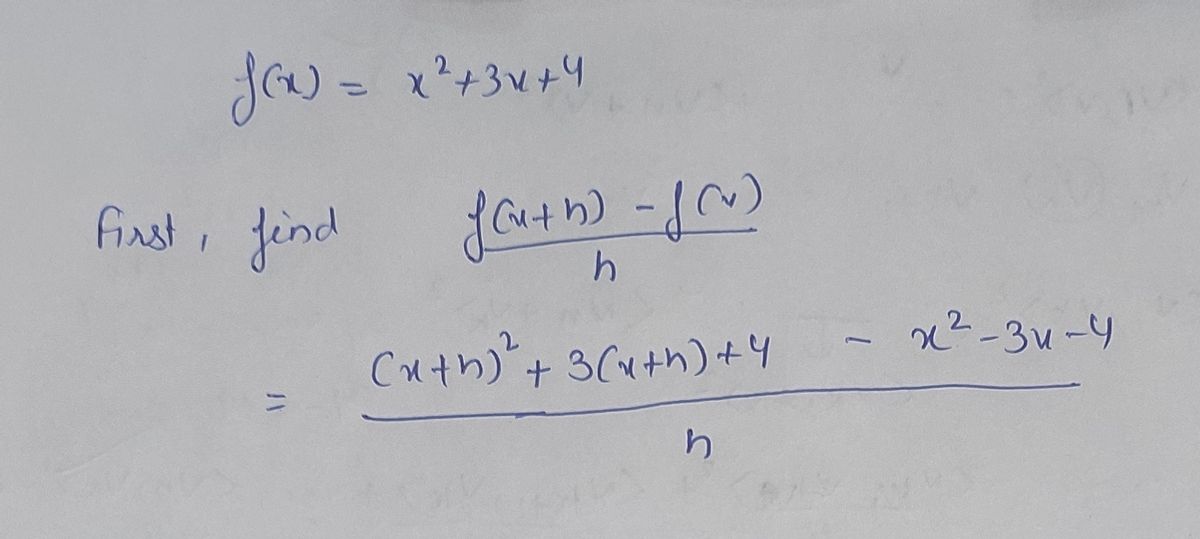f(x) = x² + 3x + 4 f(x + h) – f(x) First, find h |(x^2+2hx+h^2+3x+3h+4)/h Preview Next, simplify the numerator. |(x^2+2hx+h^2+3x+3h+4) * Preview Divide out the h. |(x^2+2hx+h^2+3x+3h+4) * Preview So now, find the limit f(x + h) – f(x) lim h→0 2x+3 Preview h
f(x) = x² + 3x + 4 f(x + h) – f(x) First, find h |(x^2+2hx+h^2+3x+3h+4)/h Preview Next, simplify the numerator. |(x^2+2hx+h^2+3x+3h+4) * Preview Divide out the h. |(x^2+2hx+h^2+3x+3h+4) * Preview So now, find the limit f(x + h) – f(x) lim h→0 2x+3 Preview h
Calculus: Early Transcendentals
8th Edition
ISBN:9781285741550
Author:James Stewart
Publisher:James Stewart
Chapter1: Functions And Models
Section: Chapter Questions
Problem 1RCC: (a) What is a function? What are its domain and range? (b) What is the graph of a function? (c) How...
Related questions
Question
![### Calculating the Derivative of a Function Using the Limit Definition
Given the function:
\[ f(x) = x^2 + 3x + 4 \]
#### Step 1: Find the Difference Quotient
To find the derivative, start by calculating the difference quotient:
\[
\frac{f(x+h) - f(x)}{h}
\]
The expression is expanded as:
\[
(x^2 + 2hx + h^2 + 3x + 3h + 4)/h
\]
**Note:** This expression is incorrect and requires simplification.
#### Step 2: Simplify the Numerator
Next, simplify the expanded expression in the numerator:
\[
(x^2 + 2hx + h^2 + 3x + 3h + 4)
\]
**Note:** The simplification should lead to canceling out terms, leading to further factoring or simplification.
#### Step 3: Divide Out the \(h\)
Factor and simplify by dividing out \(h\) from the numerator:
\[
(x^2 + 2hx + h^2 + 3x + 3h + 4)
\]
**Note:** Further simplification should be executed here, but it appears the content needs to be corrected.
#### Step 4: Find the Limit
Finally, determine the limit as \(h\) approaches zero:
\[
\lim_{{h \to 0}} \frac{f(x+h) - f(x)}{h} = 2x + 3
\]
Conclusively, the derivative of \(f(x)\) is \(2x + 3\).](/v2/_next/image?url=https%3A%2F%2Fcontent.bartleby.com%2Fqna-images%2Fquestion%2Fe044980e-0252-4007-ad93-f032ec2c5ab3%2F5e2ff6a4-e4cc-4315-8ea6-d83e9ab50ef7%2Fmax5x9l_processed.png&w=3840&q=75)
Transcribed Image Text:### Calculating the Derivative of a Function Using the Limit Definition
Given the function:
\[ f(x) = x^2 + 3x + 4 \]
#### Step 1: Find the Difference Quotient
To find the derivative, start by calculating the difference quotient:
\[
\frac{f(x+h) - f(x)}{h}
\]
The expression is expanded as:
\[
(x^2 + 2hx + h^2 + 3x + 3h + 4)/h
\]
**Note:** This expression is incorrect and requires simplification.
#### Step 2: Simplify the Numerator
Next, simplify the expanded expression in the numerator:
\[
(x^2 + 2hx + h^2 + 3x + 3h + 4)
\]
**Note:** The simplification should lead to canceling out terms, leading to further factoring or simplification.
#### Step 3: Divide Out the \(h\)
Factor and simplify by dividing out \(h\) from the numerator:
\[
(x^2 + 2hx + h^2 + 3x + 3h + 4)
\]
**Note:** Further simplification should be executed here, but it appears the content needs to be corrected.
#### Step 4: Find the Limit
Finally, determine the limit as \(h\) approaches zero:
\[
\lim_{{h \to 0}} \frac{f(x+h) - f(x)}{h} = 2x + 3
\]
Conclusively, the derivative of \(f(x)\) is \(2x + 3\).
Expert Solution
Step 1

Trending now
This is a popular solution!
Step by step
Solved in 2 steps with 2 images

Recommended textbooks for you

Calculus: Early Transcendentals
Calculus
ISBN:
9781285741550
Author:
James Stewart
Publisher:
Cengage Learning

Thomas' Calculus (14th Edition)
Calculus
ISBN:
9780134438986
Author:
Joel R. Hass, Christopher E. Heil, Maurice D. Weir
Publisher:
PEARSON

Calculus: Early Transcendentals (3rd Edition)
Calculus
ISBN:
9780134763644
Author:
William L. Briggs, Lyle Cochran, Bernard Gillett, Eric Schulz
Publisher:
PEARSON

Calculus: Early Transcendentals
Calculus
ISBN:
9781285741550
Author:
James Stewart
Publisher:
Cengage Learning

Thomas' Calculus (14th Edition)
Calculus
ISBN:
9780134438986
Author:
Joel R. Hass, Christopher E. Heil, Maurice D. Weir
Publisher:
PEARSON

Calculus: Early Transcendentals (3rd Edition)
Calculus
ISBN:
9780134763644
Author:
William L. Briggs, Lyle Cochran, Bernard Gillett, Eric Schulz
Publisher:
PEARSON

Calculus: Early Transcendentals
Calculus
ISBN:
9781319050740
Author:
Jon Rogawski, Colin Adams, Robert Franzosa
Publisher:
W. H. Freeman


Calculus: Early Transcendental Functions
Calculus
ISBN:
9781337552516
Author:
Ron Larson, Bruce H. Edwards
Publisher:
Cengage Learning